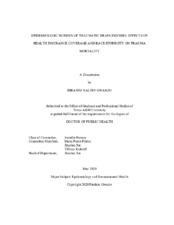| dc.contributor.advisor | Horney, Jennifer | |
| dc.creator | Gwarzo, Ibrahim Haliru | |
| dc.date.accessioned | 2020-12-17T22:14:31Z | |
| dc.date.available | 2022-05-01T07:13:58Z | |
| dc.date.created | 2020-05 | |
| dc.date.issued | 2020-04-24 | |
| dc.date.submitted | May 2020 | |
| dc.identifier.uri | https://hdl.handle.net/1969.1/191658 | |
| dc.description.abstract | Traumatic Brain Injury (TBI)-related public health burden disproportionately affects those ≥65 years of age and the growing burden of trauma-related mortality may be influenced by access to health insurance coverage and demographic characteristics such as race and ethnicity.
This project investigated the epidemiologic burden of TBIs in three papers. First, a systematic review of 34 published epidemiologic studies that provides an overview of TBI rate estimates in the U.S. The second paper used the Texas inpatient hospital discharge data to describe the TBI-related hospitalizations and investigated factors associated with in-hospital mortality among the elderly patients hospitalized with a TBI in Texas. While the third paper used trauma registry records to investigate the burden of race/ethnicity and health insurance coverage on the risk of mortality among trauma patients in Texas.
From the systematic review, we found high variability in the methodology and data sources used by studies reporting TBI estimates contributing to the differences among the reported TBI rate estimates in the U.S. From the Texas inpatient hospitalization records, the overall 3-year TBI-related hospitalization rate was 64.68 (95% CI: 63.71 – 66.50). Males accounted for 57.83% of the patients hospitalized with a TBI and the elderly (≥65 years) had higher hospitalization rates. There were racial disparities in TBI outcomes; the adjusted odds of TBI-related in-hospital mortality for Hispanics was 1.18 times that of Whites [OR = 1.18: 95% CI (1.01 – 1.40)]. From the trauma registry, we found further outcome disparities where Hispanics of any race and Non-Hispanic Blacks had higher adjusted odds of trauma mortality compared to Whites [ORHispanics= 1.25: 95% CI (1.16 – 1.36)] [ORBlacks= 2.11: 95% CI (1.87 – 2.37)]. Similarly, compared to privately insured, uninsured patients had 86% higher odds of trauma-related death [OR= 1.86: 95% CI (1.66 – 2.05)]. The effects of lack of health insurance on trauma mortality varied across race/ethnicity of the victims; uninsured Non-Hispanic Blacks had disproportionately higher adjusted odds of trauma mortality than uninsured Whites.
Using two different-statewide administrative datasets, we identified significant demographic and health insurance-related inequalities in trauma burden and outcomes. This identification could inform the design and implementation of future public health interventions. | en |
| dc.format.mimetype | application/pdf | |
| dc.language.iso | en | |
| dc.subject | Trauma | en |
| dc.subject | Traumatic-Brain-Injury | en |
| dc.subject | Disparities | en |
| dc.subject | Health-Insurance | en |
| dc.subject | Race/Ethnicity | en |
| dc.subject | Texas | en |
| dc.title | Epidemiologic Burden Of Traumatic Brain Injuries: Effects of Health Insurance Coverage and Race/Ethnicity on Trauma Mortality | en |
| dc.type | Thesis | en |
| thesis.degree.department | Epidemiology and Biostatistics | en |
| thesis.degree.discipline | Epidemiology and Environmental Health | en |
| thesis.degree.grantor | Texas A&M University | en |
| thesis.degree.name | Doctor of Public Health | en |
| thesis.degree.level | Doctoral | en |
| dc.contributor.committeeMember | Xu, Xiaohui | |
| dc.contributor.committeeMember | Perez-Patron, Maria | |
| dc.contributor.committeeMember | Radcliff, Tiffany | |
| dc.type.material | text | en |
| dc.date.updated | 2020-12-17T22:14:31Z | |
| local.embargo.terms | 2022-05-01 | |
| local.etdauthor.orcid | 0000-0002-0794-179X | |


